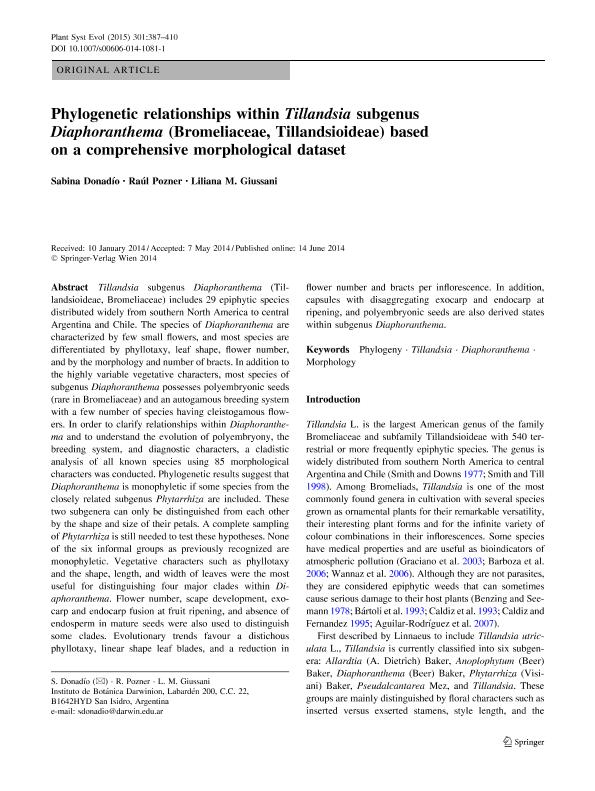Mostrar el registro sencillo del ítem
dc.contributor.author
Donadío, Sabina

dc.contributor.author
Pozner, Raul Ernesto

dc.contributor.author
Giussani, Liliana Mónica

dc.date.available
2017-06-26T23:27:54Z
dc.date.issued
2015-01
dc.identifier.citation
Donadío, Sabina; Pozner, Raul Ernesto; Giussani, Liliana Mónica; Phylogenetic relationships within Tillandsia subgenus Diaphoranthema (Bromeliaceae, Tillandsioideae) based on a comprehensive morphological dataset; Springer Wien; Plant Systematics and Evolution; 301; 1; 1-2015; 387-410
dc.identifier.issn
0378-2697
dc.identifier.uri
http://hdl.handle.net/11336/18972
dc.description.abstract
Tillandsia subgenus Diaphoranthema (Tillandsioideae, Bromeliaceae) includes 29 epiphytic species distributed widely from southern North America to central Argentina and Chile. The species of Diaphoranthema are characterized by few small flowers, and most species are differentiated by phyllotaxy, leaf shape, flower number, and by the morphology and number of bracts. In addition to the highly variable vegetative characters, most species of subgenus Diaphoranthema possesses polyembryonic seeds (rare in Bromeliaceae) and an autogamous breeding system with a few number of species having cleistogamous flowers. In order to clarify relationships within Diaphoranthema and to understand the evolution of polyembryony, the breeding system, and diagnostic characters, a cladistic analysis of all known species using 85 morphological characters was conducted. Phylogenetic results suggest that Diaphoranthema is monophyletic if some species from the closely related subgenus Phytarrhiza are included. These two subgenera can only be distinguished from each other by the shape and size of their petals. A complete sampling of Phytarrhiza is still needed to test these hypotheses. None of the six informal groups as previously recognized are monophyletic. Vegetative characters such as phyllotaxy and the shape, length, and width of leaves were the most useful for distinguishing four major clades within Diaphoranthema. Flower number, scape development, exocarp and endocarp fusion at fruit ripening, and absence of endosperm in mature seeds were also used to distinguish some clades. Evolutionary trends favour a distichous phyllotaxy, linear shape leaf blades, and a reduction in flower number and bracts per inflorescence. In addition, capsules with disaggregating exocarp and endocarp at ripening, and polyembryonic seeds are also derived states within subgenus Diaphoranthema.
dc.format
application/pdf
dc.language.iso
eng
dc.publisher
Springer Wien

dc.rights
info:eu-repo/semantics/openAccess
dc.rights.uri
https://creativecommons.org/licenses/by-nc-sa/2.5/ar/
dc.subject
Phylogeny
dc.subject
Tillandsia
dc.subject
Diaphoranthema
dc.subject
Morphology
dc.subject.classification
Ciencias de las Plantas, Botánica

dc.subject.classification
Ciencias Biológicas

dc.subject.classification
CIENCIAS NATURALES Y EXACTAS

dc.title
Phylogenetic relationships within Tillandsia subgenus Diaphoranthema (Bromeliaceae, Tillandsioideae) based on a comprehensive morphological dataset
dc.type
info:eu-repo/semantics/article
dc.type
info:ar-repo/semantics/artículo
dc.type
info:eu-repo/semantics/publishedVersion
dc.date.updated
2017-06-26T21:34:34Z
dc.identifier.eissn
2199-6881
dc.journal.volume
301
dc.journal.number
1
dc.journal.pagination
387-410
dc.journal.pais
Austria

dc.journal.ciudad
Viena
dc.description.fil
Fil: Donadío, Sabina. Consejo Nacional de Investigaciones Científicas y Técnicas. Instituto de Botánica Darwinion. Academia Nacional de Ciencias Exactas, Físicas y Naturales. Instituto de Botánica Darwinion; Argentina
dc.description.fil
Fil: Pozner, Raul Ernesto. Consejo Nacional de Investigaciones Científicas y Técnicas. Instituto de Botánica Darwinion. Academia Nacional de Ciencias Exactas, Físicas y Naturales. Instituto de Botánica Darwinion; Argentina
dc.description.fil
Fil: Giussani, Liliana Mónica. Consejo Nacional de Investigaciones Científicas y Técnicas. Instituto de Botánica Darwinion. Academia Nacional de Ciencias Exactas, Físicas y Naturales. Instituto de Botánica Darwinion; Argentina
dc.journal.title
Plant Systematics and Evolution

dc.relation.alternativeid
info:eu-repo/semantics/altIdentifier/url/https://link.springer.com/article/10.1007/s00606-014-1081-1
dc.relation.alternativeid
info:eu-repo/semantics/altIdentifier/doi/http://dx.doi.org/10.1007/s00606-014-1081-1
Archivos asociados
